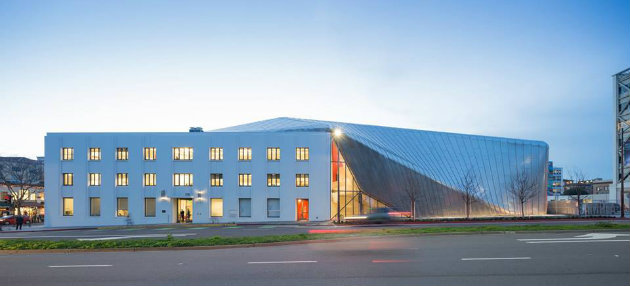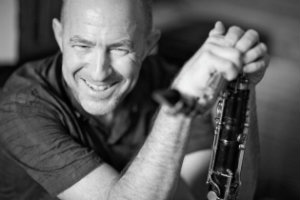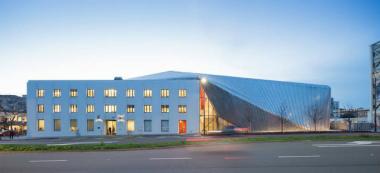
Although the Berkeley Art Museum and Pacific Film Archive has snuggled into a new, seismically safe home in downtown Berkeley, don’t think they’re not about to shake things up.
At the opening of the former UC Berkeley printing plant redesigned by Diller Scofidio + Renfro on Jan. 31, visitors encountered a building cloaked in a magnificent sheer steel drape and an interior that resembles a cosmic spaceship built by a sophisticated farmhand. Soon enough, a completely refurbished monthly music series, Full, will fill areas of the museum with experimental, listen-and-ramble performances.
BAMPFA’s previous after-hours, new-music series was known as “L@TE” and curated by Berkeley pianist Sarah Cahill. L@TE transformed Gallery B in the museum’s former, multi-storied digs on Bancroft Way into an enormous concert hall — with ADA-accessible ramps and upper galleries providing dizzying, crow’s nest perspectives and the vast space easily accommodating a large, dancing audience. Contemporary music, films, dance, and experiential art placed the Friday night events in high demand: Artists like Terry Riley, who Cahill had both launch and close the five-year series, drew nearly 1,000 people.
Full also is curated by Cahill and continues to feature mostly Bay Area artists creating adventurous, experimental music. Modeled on annual solstice concerts that Cahill has programmed at Oakland’s Chapel of the Chimes since 1995, the concerts at BAMPFA are scheduled on the night of each month’s full moon, with performers located throughout the museum.
“The idea is to have music all around the building,” says Cahill. “Like our June 21st solstice concerts it will be ambulatory, with different artists in the amphitheater, a back atrium and an upper balcony.”
Architecture that has walls that don’t extend all the way to the ceiling leaves Cahill eager to discover the possibilities: Will acoustical overlap create desirable, impromptu collaborations, or confusion? At least for the first few shows, artists will perform in sequence instead of simultaneously. “The newness of the space is youthful, liberating. Concert halls make people feel hemmed in — but we’ll have to learn how things are interconnected in terms of sound,” she says.
Program Manager Sean Carson says that while a choir in the old space’s large atrium sounded terrific, new-music ensembles, spoken-word artists, and lyric-intense musicians such as rappers suffered. “While we’re keeping the informal, accessible atmosphere here, better acoustics mean we’re bumping the quality of sound. The human voice will be much clearer in these spaces,” says Carson.
Two film theaters equipped with Meyer Sound systems — one with 33 seats and another with 232 seats and a bandshell large enough to accommodate a small ensemble without obscuring sight lines — offer intriguing future options for film and live music combinations. Furthermore, depending on the exhibit coinciding with a Full event, Cahill says additional gallery spaces in the new building may allow musicians to roam along with audiences or perform in areas they’ve not yet explored. New music, she says, is inherently fluid and changeable. “Classical music can’t adapt to fit (new and different) spaces. Other than volume, it’s notated and much more set. With these performers, it’s all about sound and using the space to its advantage.”

Full events are programmed thematically: Full: First features composer-performers (Feb. 22); Full: Voice is an exploration of the human voice (March 23); Full: Invent has musicians performing on homemade and experimental instruments (Apr. 21).
Cahill says the artists in the opening concert demonstrate the range she enjoys presenting, even within one thematic category. Virtuoso clarinetist Evan Ziporyn brings a project that includes a video element; Oakland-based Amy X Neuburg is trained as an opera singer and uses contemporary devices like looping to create her playful, intelligent vocal investigations; Luciano Chessa is “fearless” when it comes to applying unorthodox ideas to classical forms. With Voice, the March performance, the focus turns to story and character. “Pamela Z is amazing: a riveting performer, very theatrical. In the L@TE series, Richard (Mix) did a piece by Julian Eastman, a gay composer who died of AIDS, that was astonishing. He was in a corner of the museum — it was so moving. We’re having him repeat it here. And we’ll have the Cornelius Cardew Choir that specializes in new approaches to 20th-century music,” says Cahill.
The Invent performance highlights instruments that to Cahill represent near-art objects. She says Paul Dresher’s dumpster-diving to retrieve scavenged goods for his unusual instruments and Laura Inserra’s collected instruments brought from around the world — including one from Switzerland, called the Hang, that reminds her of a flying saucer — result in “things that just seemed right for an art museum.”
Cahill says she has no definite plans to perform in the series, but might put herself on the 100th Birthday Full program she is planning that will celebrate the life and work of composer Lou Harrison in 2017. What will happen in future Full events is impossible to forecast with pinpoint accuracy; exactly the way Cahill would have it be. “It’s new, with many things unknown,” she says. “I overheard the vibe of the new space described by a 17-year-old as ‘youthful.’ I think that’s a good thing.”

